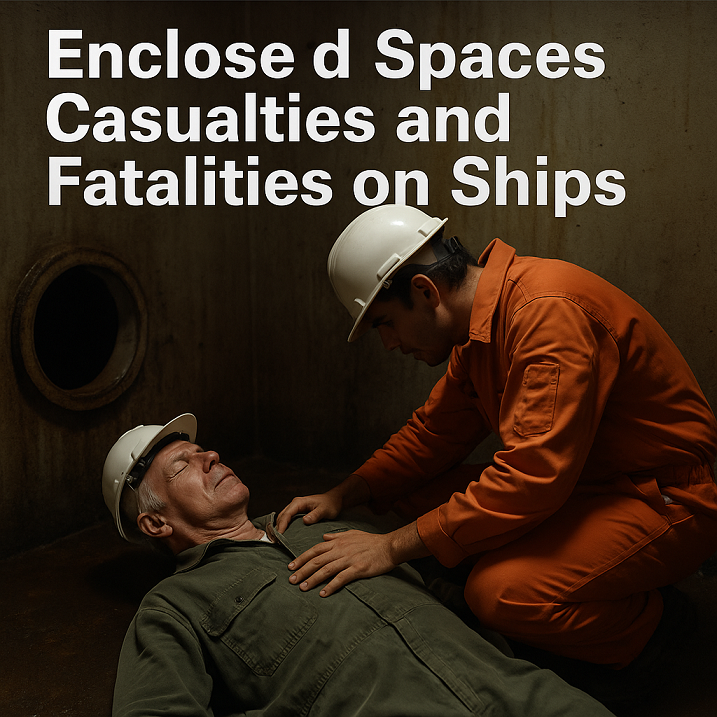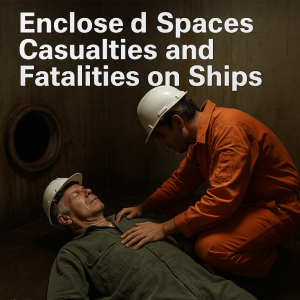Enclosed spaces onboard ships are among the most hazardous work environments in the maritime industry. Despite global regulations and training programs, accidents continue to occur—often with fatal consequences. This article provides a complete guide on enclosed space hazards, prevention strategies, and emergency response procedures, helping seafarers and maritime professionals stay safe at sea.
⚓ Did you know? According to the IMO, enclosed space accidents account for dozens of fatalities annually, with many more injuries caused by oxygen deficiency, toxic gases, and non-compliance with safety protocols.
What Are Enclosed Spaces on Ships?
Enclosed spaces on ships are confined areas with limited entry/exit points, poor ventilation, and not designed for continuous occupancy. These spaces pose serious safety risks due to potential oxygen deficiency, toxic gases, or flammable atmospheres. Common examples include cargo holds, ballast tanks, chain lockers, pump rooms, and cofferdams. Proper identification and risk assessment of these spaces are crucial for preventing accidents. Understanding their dangers ensures compliance with SOLAS and IMO regulations, safeguarding crew members from life-threatening hazards. Enclosed spaces are areas with:
-
Limited openings for entry or exit
-
Restricted ventilation
-
Not intended for regular human occupancy
🔍 Common Enclosed Spaces Include:
Ships contain various high-risk enclosed spaces like cargo holds, fuel tanks, chain lockers, and pump rooms. Each presents unique hazards depending on vessel type and cargo. Understanding these spaces is crucial for implementing proper safety measures and complying with maritime regulations. Ships contain multiple enclosed spaces that require strict safety protocols. Key areas include:
-
Cargo holds – Used for storage but may trap hazardous gases.
-
Ballast & fuel tanks – Prone to oxygen depletion and toxic fumes.
-
Chain lockers – Often overlooked but can accumulate dangerous gases.
-
Pump rooms – High risk of flammable vapor buildup.
-
Double bottoms & cofferdams – Tight spaces with restricted airflow.
Recognizing these spaces helps in implementing proper ventilation, gas testing, and entry permits to minimize risks.
——————————
☠️ Key Hazards in Enclosed Spaces
Enclosed spaces pose deadly combinations of oxygen deficiency, toxic gases (like H₂S and CO), and explosive atmospheres. Physical dangers include poor visibility, slippery surfaces, and restricted movement. Conditions can deteriorate rapidly, requiring continuous atmospheric monitoring with proper gas detectors.
| Hazard Type | Risk Description |
|---|---|
| Oxygen Deficiency | Caused by rusting, cargo decay, or chemical reactions |
| Toxic Gas Accumulation | Gases like H₂S, CO, and methane can be fatal |
| Flammable Atmospheres | Fuel or cargo vapors can explode with a spark |
| Physical Hazards | Slips, falls, structural obstructions, or poor visibility |
📌 Internal Link Tip: Link to related articles such as:
👉 Shipboard Gas Detection Systems
👉 Fire and Explosion Safety on Ships
——————————
⚠️ Common Causes of Enclosed Space Incidents
Most accidents result from inadequate training, skipped safety procedures, improper ventilation, lack of PPE use, and rushed rescue attempts. Underlying issues often include production pressures and complacency, even in frequently accessed spaces.
1. Lack of Training and Hazard Awareness
-
Many accidents occur due to insufficient knowledge of space-specific dangers.
2. Improper Risk Assessments
-
Failure to assess atmospheric hazards or use entry checklists can lead to unanticipated risks.
3. Inadequate Ventilation and Gas Testing
-
Spaces without forced ventilation quickly become lethal.
4. Non-Compliance with PPE Usage
-
Skipping essential PPE like SCBAs or harnesses results in vulnerability.
5. Unauthorized Entry and Protocol Bypass
-
Time pressure, poor communication, or complacency are leading causes.
——————————
✅ Enclosed Space Safety: Prevention Measures
Effective prevention requires comprehensive training, strict permit-to-work systems, continuous gas monitoring, proper PPE use, and maintained emergency equipment. Clear communication and marked entry points help institutionalize safety awareness onboard.
1. Training and Emergency Drills
- ✔️ Mandatory IMO training
- ✔️ Regular enclosed space entry and rescue drills
2. Permit-to-Work and SOP Compliance
- 📝 Always use a permit-to-work system
- ✅ Implement pre-entry checklists
3. Atmospheric Testing & Ventilation
- 🔍 Use multi-gas detectors (O₂, LEL, H₂S, CO)
- 💨 Apply mechanical/forced ventilation pre- and during entry
4. Personal Protective Equipment (PPE)
- 🛡️ SCBA (Self-Contained Breathing Apparatus)
- 🧤 Helmets, gloves, flame-resistant clothing, safety harnesses
5. Communication & Standby Monitoring
- 📻 Radio communication
- 👀 Dedicated watchperson outside the space
——————————
🚨 Rescue and Emergency Response Procedures
Enclosed space rescues demand trained teams with proper equipment – untrained attempts often cause more deaths. Immediate emergency response, proper ventilation, medical readiness, and thorough incident investigations are critical for effective rescue operations. Quick and structured response is critical in saving lives during an enclosed space emergency.
1. Raise Alarm Immediately
-
Activate the vessel’s emergency system and notify officers.
2. Deploy Trained Rescue Team
-
Must use SCBA, harnesses, and lifelines—no unprotected entry.
3. Ensure Ventilation and Test Air Again
-
Avoid “rescue by reflex”—verify air quality first.
4. Administer First Aid Promptly
-
Stabilize victim and prepare for medevac if needed.
5. Report, Investigate, and Improve
-
Root cause analysis should lead to updated SOPs and training.
——————————
📚 Case Studies: Real-Life Incidents and Lessons Learned
Past tragedies reveal common patterns: skipped safety checks in “routine” spaces lead to fatalities, while proper gas detection and training prevent disasters. Recurring similar accidents show the industry must better implement known safety measures.
⚫ Fatal Bulk Carrier Incident – 2020
A crew entered a cargo hold without testing the atmosphere. The result: multiple fatalities. The investigation found no risk assessment or PPE enforcement.
🟢 Successful Tanker Evacuation – 2022
Toxic gas sensors activated early warnings. Quick evacuation, trained personnel, and robust drills prevented casualties.
——————————
💡 Pro Tips for Maritime Professionals
Always treat enclosed spaces as immediately dangerous. Use certified equipment, implement buddy systems, conduct regular training, and encourage near-miss reporting. Exceeding minimum safety standards saves lives – complacency kills.
-
Never assume a space is safe just because it was recently used.
-
Use ATEX-certified equipment in potentially flammable environments.
-
Update and review training certifications annually.
-
Reinforce a zero-tolerance safety culture onboard.
📺
🎥 Video: “Enclosed Space Entry Procedures & Rescue Demonstration – IMO Guidelines Explained”
——————————
❓ FAQs – Enclosed Space Entry on Ships
Q1: What is the minimum oxygen level required for safe entry?
A: According to IMO, oxygen must be between 19.5% and 23.5%.
Q2: Can a CO₂ fire extinguisher create a hazard in enclosed spaces?
A: Yes, excessive CO₂ can displace oxygen, creating an oxygen-deficient atmosphere.
Q3: Are permits needed for every enclosed space entry?
A: Absolutely. Every single entry must be authorized via the permit-to-work system.
——————————
🚀 CTA: Learn More & Stay Safe
Want to boost your crew’s awareness and compliance?
👉 Entering Enclosed Spaces on Ships: A Guide to Safety Onboard
👉 Maritime First Aid Training: Life-Saving Skills for Seafarers at Sea
👉 enclosed_space_entry_shipboard_checklist_fillable
——————————
🧭 Final Thoughts
Enclosed space incidents remain one of the leading causes of onboard fatalities. Through proactive training, rigorous procedures, real-time monitoring, and a culture of safety, maritime professionals can significantly reduce risks and save lives.
Safety is not optional—it’s survival.
Read more here :
Enclosed Spaces on Ships: Dangers, Safety Procedures, and Rescue Operations
Entering Enclosed Spaces on Ships: A Guide to Safety Onboard



thank you.